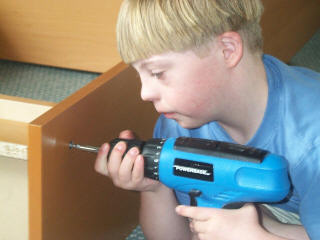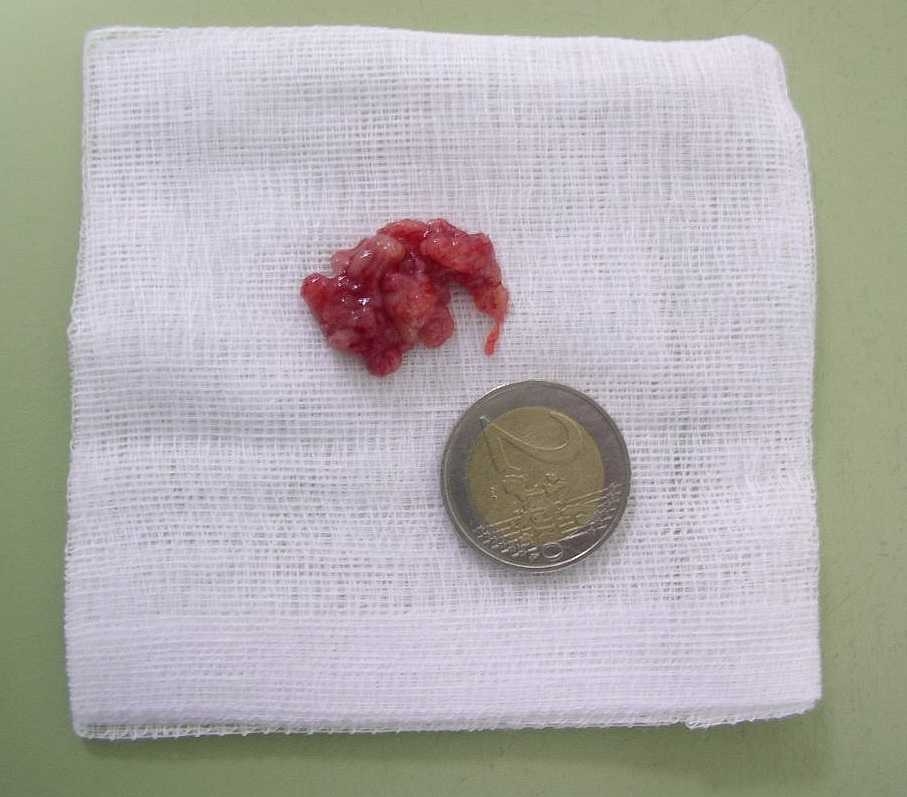|
Grisel's Syndrome
Grisel's syndrome is a non-traumatic subluxation of the atlanto-axial joint caused by inflammation of the adjacent tissues. This is a rare disease that usually affects children. Progressive throat and neck pain and neck stiffness can be followed by neurologic symptoms such as pain or numbness radiating to arms ( radiculopathies). In extreme cases, the condition can lead to quadriplegia and even death from acute respiratory failure. The condition often follows soft tissue inflammation in the neck such as in cases of upper respiratory tract infections, peritonsillar or retropharyngeal abscesses. Post-operative inflammation after certain procedures such as adenoidectomy can also lead to this condition in susceptible individuals such as those with Down syndrome. Pathophysiology Pathophysiology of this disease consists of relaxation of the transverse ligament of the atlanto-axial joint. Diagnosis Diagnosis can be established using plain film x-rays as well as CT scan ... [...More Info...] [...Related Items...] OR: [Wikipedia] [Google] [Baidu] |
Subluxation
A subluxation is an incomplete or partial dislocation of a joint or organ. According to the World Health Organization (WHO), a subluxation is a "significant structural displacement", and is therefore always visible on static imaging studies, such as X-rays. In contrast, the chiropractic belief of " vertebral subluxation" may or may not involve a significant displacement or even pain or clear dysfunction.WHO guidelines on basic training and safety in chiropractic p. 4, including footnote. Joints [...More Info...] [...Related Items...] OR: [Wikipedia] [Google] [Baidu] |
Down Syndrome
Down syndrome or Down's syndrome, also known as trisomy 21, is a genetic disorder caused by the presence of all or part of a third copy of chromosome 21. It is usually associated with child development, physical growth delays, mild to moderate intellectual disability, and Facies (medical), characteristic facial features. The average IQ of a young adult with Down syndrome is 50, equivalent to the mental ability of an eight- or nine-year-old child, but this can vary widely. The parents of the affected individual are usually genetically normal. The probability increases from less than 0.1% in 20-year-old mothers to 3% in those of age 45. The extra chromosome is believed to occur by chance, with no known behavioral activity or environmental factor that changes the probability. Down syndrome can be identified during pregnancy by prenatal screening followed by diagnostic testing or after birth by direct observation and genetic testing. Since the introduction of screening, Down syndr ... [...More Info...] [...Related Items...] OR: [Wikipedia] [Google] [Baidu] |
Sequelae
A sequela (, ; usually used in the plural, sequelae ) is a pathological condition resulting from a disease, injury, therapy, or other trauma. Derived from the Latin word, meaning “sequel”, it is used in the medical field to mean a complication or condition following a prior illness or disease. A typical sequela is a chronic complication of an acute condition—in other words, a long-term effect of a temporary disease or injury—which follows immediately from the condition. Sequelae differ from late effects, which can appear long after—even several decades after—the original condition has resolved. In general, non-medical usage, the terms ''sequela'' and ''sequelae'' mean consequence and consequences. Examples and uses Chronic kidney disease, for example, is sometimes a sequela of diabetes; "chronic constipation" or more accurately "obstipation" (that is, inability to pass stool or gas) is a sequela to an intestinal obstruction; and neck pain is a common sequela o ... [...More Info...] [...Related Items...] OR: [Wikipedia] [Google] [Baidu] |
Antibiotics
An antibiotic is a type of antimicrobial substance active against bacteria. It is the most important type of antibacterial agent for fighting bacterial infections, and antibiotic medications are widely used in the treatment and prevention of such infections. They may either kill or inhibit the growth of bacteria. A limited number of antibiotics also possess antiprotozoal activity. Antibiotics are not effective against viruses such as the common cold or influenza; drugs which inhibit viruses are termed antiviral drugs or antivirals rather than antibiotics. Sometimes, the term ''antibiotic''—literally "opposing life", from the Greek roots ἀντι ''anti'', "against" and βίος ''bios'', "life"—is broadly used to refer to any substance used against microbes, but in the usual medical usage, antibiotics (such as penicillin) are those produced naturally (by one microorganism fighting another), whereas non-antibiotic antibacterials (such as sulfonamides and antise ... [...More Info...] [...Related Items...] OR: [Wikipedia] [Google] [Baidu] |
Anti-inflammatory
Anti-inflammatory is the property of a substance or treatment that reduces inflammation or swelling. Anti-inflammatory drugs, also called anti-inflammatories, make up about half of analgesics. These drugs remedy pain by reducing inflammation as opposed to opioids, which affect the central nervous system to block pain signaling to the brain. Nonsteroidal anti-inflammatory drugs Nonsteroidal anti-inflammatory drugs (NSAIDs) alleviate pain by counteracting the cyclooxygenase (COX) enzyme. On its own, COX enzyme synthesizes prostaglandins, creating inflammation. In whole, the NSAIDs prevent the prostaglandins from ever being synthesized, reducing or eliminating the inflammation and resulting pain. Some common examples of NSAIDs are aspirin, ibuprofen, and naproxen. The newer specific COX-inhibitors are not classified together with the traditional NSAIDs, even though they presumably share the same mode of action. On the other hand, there are analgesics that are commonly associa ... [...More Info...] [...Related Items...] OR: [Wikipedia] [Google] [Baidu] |
CT Scan
A computed tomography scan (CT scan; formerly called computed axial tomography scan or CAT scan) is a medical imaging technique used to obtain detailed internal images of the body. The personnel that perform CT scans are called radiographers or radiology technologists. CT scanners use a rotating X-ray tube and a row of detectors placed in a gantry to measure X-ray attenuations by different tissues inside the body. The multiple X-ray measurements taken from different angles are then processed on a computer using tomographic reconstruction algorithms to produce tomographic (cross-sectional) images (virtual "slices") of a body. CT scans can be used in patients with metallic implants or pacemakers, for whom magnetic resonance imaging (MRI) is contraindicated. Since its development in the 1970s, CT scanning has proven to be a versatile imaging technique. While CT is most prominently used in medical diagnosis, it can also be used to form images of non-living objects. The 1979 N ... [...More Info...] [...Related Items...] OR: [Wikipedia] [Google] [Baidu] |
X-rays
X-rays (or rarely, ''X-radiation'') are a form of high-energy electromagnetic radiation. In many languages, it is referred to as Röntgen radiation, after the German scientist Wilhelm Conrad Röntgen, who discovered it in 1895 and named it ''X-radiation'' to signify an unknown type of radiation.Novelline, Robert (1997). ''Squire's Fundamentals of Radiology''. Harvard University Press. 5th edition. . X-ray wavelengths are shorter than those of ultraviolet rays and longer than those of gamma rays. There is no universally accepted, strict definition of the bounds of the X-ray band. Roughly, X-rays have a wavelength ranging from 10 nanometers to 10 picometers, corresponding to frequencies in the range of 30 petahertz to 30 exahertz ( to ) and photon energies in the range of 100 eV to 100 keV, respectively. X-rays can penetrate many solid substances such as construction materials and living tissue, so X-ray radiography is widely used in medic ... [...More Info...] [...Related Items...] OR: [Wikipedia] [Google] [Baidu] |
Transverse Ligament
A transverse ligament is a ligament on a transverse plane, orthogonal to the anteroposterior or oral-aboral axiscan of the body. In human anatomy, examples are: * Flexor retinaculum of the hand or transverse carpal ligament (ligamentum carpi transversum) * Inferior transverse ligament of scapula (ligamentum transversum scapulae inferius) * Inferior transverse ligament of the tibiofibular syndesmosis * Superior transverse ligament of the scapula (ligamentum transversum scapulae superius) * Superior extensor retinaculum of foot or transverse crural ligament (ligamentum transversum cruris) * Transverse acetabular ligament (ligamentum transversum acetabuli) * Transverse humeral ligament (ligamentum transversum humeri) * Transverse ligament of the atlas (ligamentum transversum atlantis) * Transverse ligament of knee The transverse or nteriormeniscomeniscal ligament is a ligament in the knee joint that connects the anterior convex margin of the lateral meniscus to the anterio ... [...More Info...] [...Related Items...] OR: [Wikipedia] [Google] [Baidu] |
Pathophysiology
Pathophysiology ( physiopathology) – a convergence of pathology with physiology – is the study of the disordered physiological processes that cause, result from, or are otherwise associated with a disease or injury. Pathology is the medical discipline that describes conditions typically ''observed'' during a disease state, whereas physiology is the biological discipline that describes processes or mechanisms ''operating'' within an organism. Pathology describes the abnormal or undesired condition, whereas pathophysiology seeks to explain the functional changes that are occurring within an individual due to a disease or pathologic state. History Etymology The term ''pathophysiology'' comes from the Ancient Greek πάθος (''pathos'') and φυσιολογία (''phusiologia''). Nineteenth century Reductionism In Germany in the 1830s, Johannes Müller led the establishment of physiology research autonomous from medical research. In 1843, the Berlin Physical S ... [...More Info...] [...Related Items...] OR: [Wikipedia] [Google] [Baidu] |
Adenoidectomy
Adenoidectomy is the surgical removal of the adenoid for reasons which include impaired breathing through the nose, chronic infections, or recurrent earaches. The effectiveness of removing the adenoids in children to improve recurrent nasal symptoms and/or nasal obstruction has not been well studied. The surgery is less commonly performed in adults in whom the adenoid is much smaller and less active than it is in children. It is most often done on an outpatient basis under general anesthesia. Post-operative pain is generally minimal and reduced by icy or cold foods. The procedure is often combined with tonsillectomy (this combination is usually called an "adenotonsillectomy" or "T&A"), for which the recovery time is an estimated 10–14 days, sometimes longer, mostly dependent on age. Adenoidectomy is not often performed under one year of age as adenoid function is part of the body's immune system but its contribution to this decreases progressively beyond this age. Medical uses T ... [...More Info...] [...Related Items...] OR: [Wikipedia] [Google] [Baidu] |
Atlanto-axial Joint
The atlanto-axial joint is a joint in the upper part of the neck between the atlas bone and the axis bone, which are the first and second cervical vertebrae. It is a pivot joint. Structure The atlanto-axial joint is a joint between the atlas bone and the axis bone, which are the first and second cervical vertebrae. It is a pivot joint. There is a pivot articulation between the odontoid process of the axis and the ring formed by the anterior arch and the transverse ligament of the atlas. Lateral and median joints There are three atlanto-axial joints: one median and two lateral: * The median atlanto-axial joint is sometimes considered a triple joint: ** one between the posterior surface of the anterior arch of atlas and the front of the odontoid process ** one between the anterior surface of the ligament and the back of the odontoid process * The lateral atlantoaxial joint involves the lateral mass of atlas and axis. Between the articular processes of the two bones there ... [...More Info...] [...Related Items...] OR: [Wikipedia] [Google] [Baidu] |
Retropharyngeal Abscess
Retropharyngeal abscess (RPA) is an abscess located in the tissues in the back of the throat behind the posterior pharyngeal wall (the retropharyngeal space). Because RPAs typically occur in deep tissue, they are difficult to diagnose by physical examination alone. RPA is a relatively uncommon illness, and therefore may not receive early diagnosis in children presenting with stiff neck, malaise, difficulty swallowing, or other symptoms listed below. Early diagnosis is key, while a delay in diagnosis and treatment may lead to death. Parapharyngeal space communicates with retropharyngeal space and an infection of retropharyngeal space can pass down behind the esophagus into the mediastinum. RPAs can also occur in adults of any age. RPA can lead to airway obstruction or sepsis – both life-threatening emergencies. Fatalities normally occur from patients not receiving treatment immediately and suffocating prior to knowing that anything serious was wrong. Signs and symptoms Signs and ... [...More Info...] [...Related Items...] OR: [Wikipedia] [Google] [Baidu] |





